Abstract
The use of a corrective orthopaedic brace is an established form of management for patients with progressive idiopathic scoliosis. Thirteen patients with mild idiopathic scoliosis were studied with and without the corrective brace applied. Lung volumes and the pattern of chest wall and abdominal movement were measured during quiet breathing. Transdiaphragmatic pressures were measured in six of the patients and upper ribcage movement in seven patients. Application of the brace resulted in a significant reduction in vital capacity (14%), functional residual capacity (22%), and total lung capacity (12%). There was no effect on respiratory rate or minute volume. In the erect position the pattern of chest wall movement was altered with a reduction in lower ribcage movement of 46% and abdominal wall of 39% and an increase in upper ribcage movement of 43%. These changes were greater in the supine position. There was at least a twofold increase in end inspiratory and end expiratory gastric pressures during tidal breathing, but oesophageal pressures were not affected by the brace. Transdiaphragmatic pressures showed a similar twofold increase, which implies a substantial increase in the work of breathing. In view of the doubts concerning the influence of bracing on the natural history of idiopathic scoliosis and the substantial functional effect of bracing on the respiratory system, it is suggested that the current practice of bracing in this condition needs to be reviewed.
Full text
PDF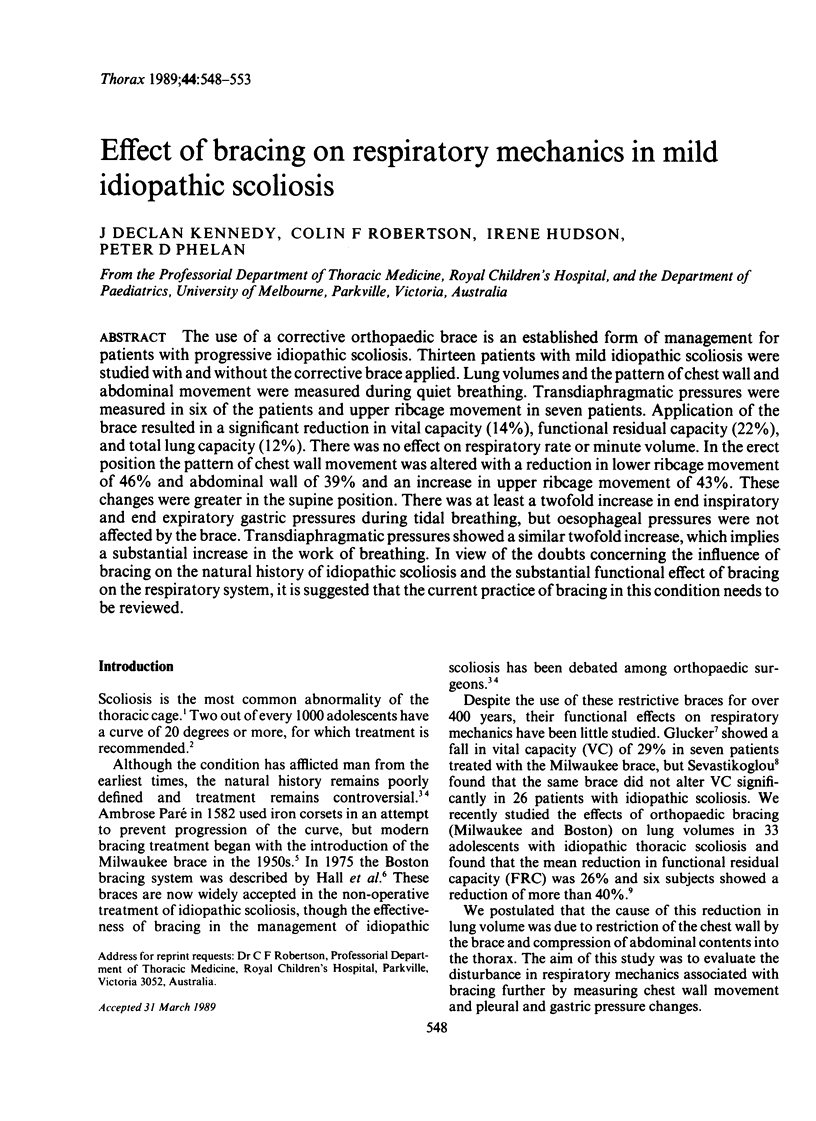
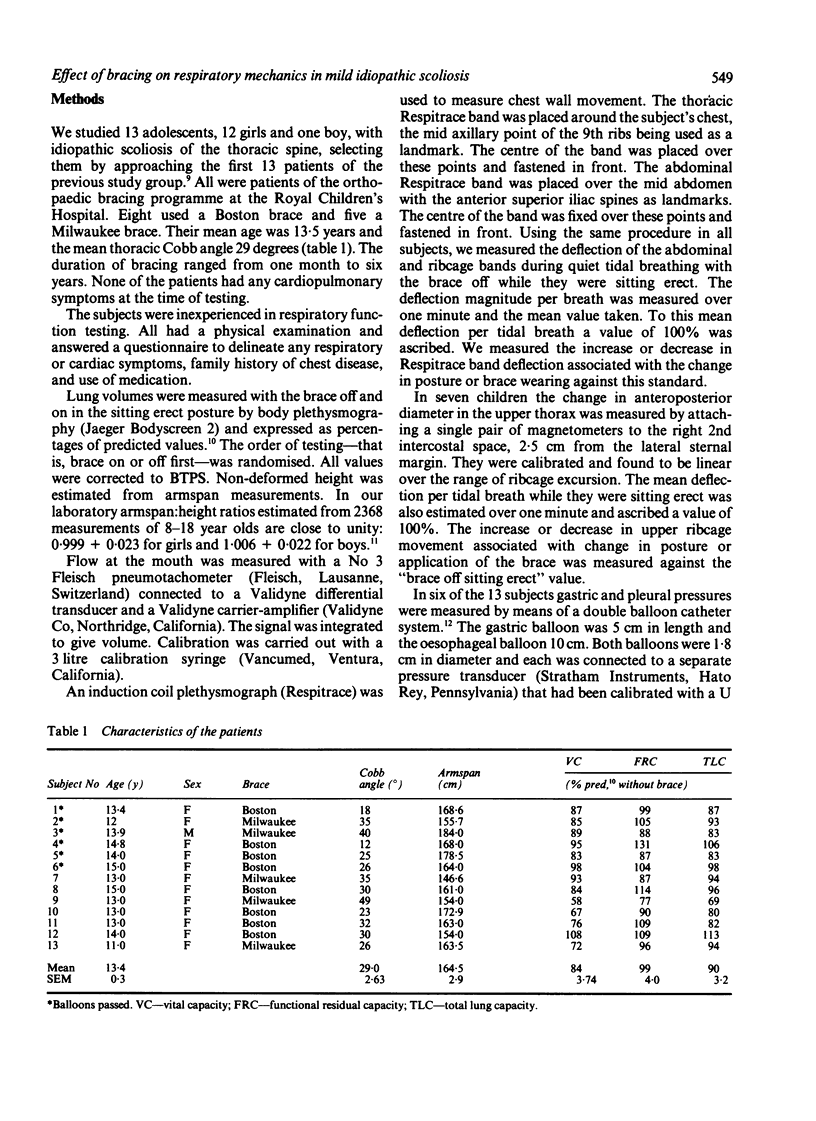
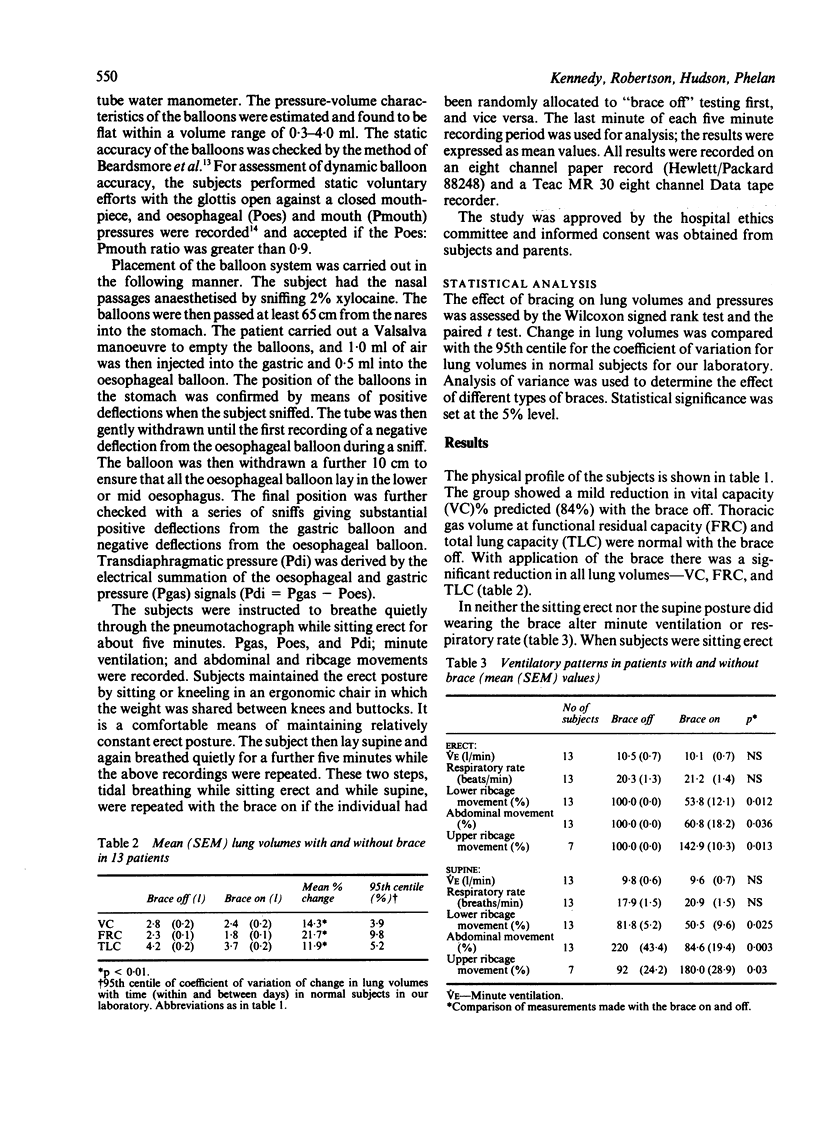
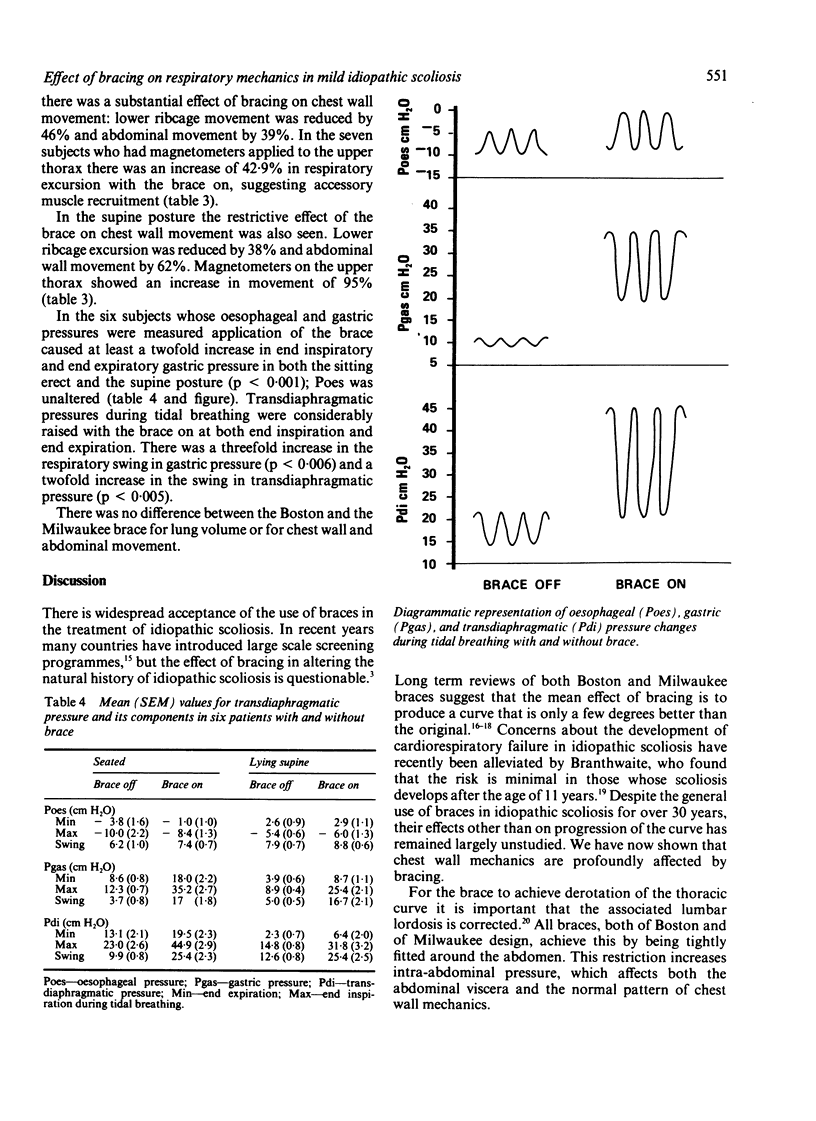
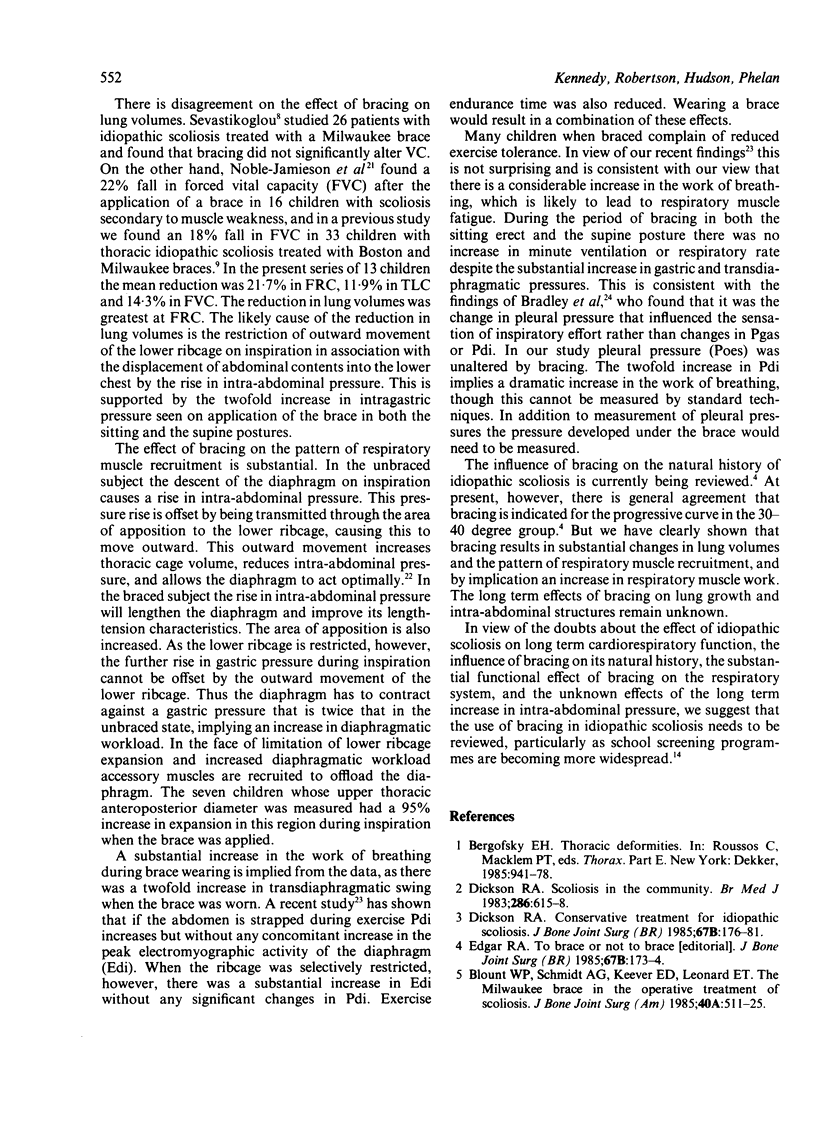
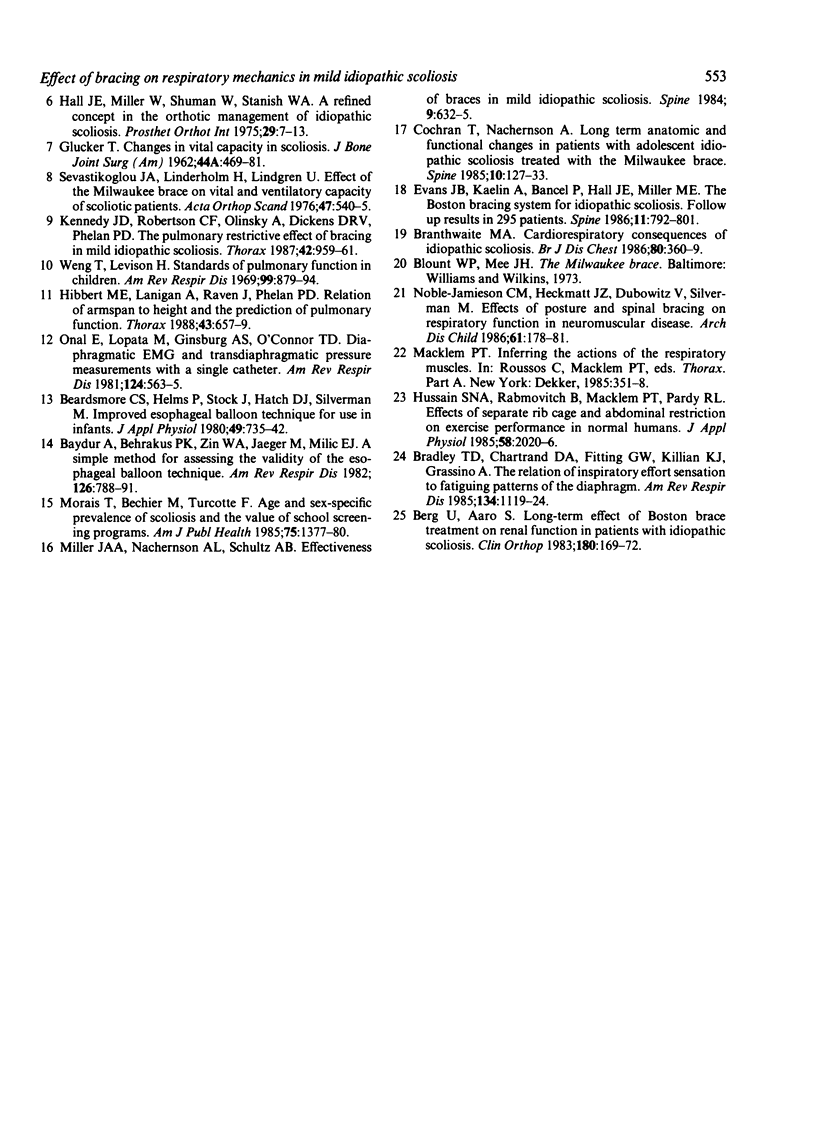
Selected References
These references are in PubMed. This may not be the complete list of references from this article.
- Baydur A., Behrakis P. K., Zin W. A., Jaeger M., Milic-Emili J. A simple method for assessing the validity of the esophageal balloon technique. Am Rev Respir Dis. 1982 Nov;126(5):788–791. doi: 10.1164/arrd.1982.126.5.788. [DOI] [PubMed] [Google Scholar]
- Beardsmore C. S., Helms P., Stocks J., Hatch D. J., Silverman M. Improved esophageal balloon technique for use in infants. J Appl Physiol Respir Environ Exerc Physiol. 1980 Oct;49(4):735–742. doi: 10.1152/jappl.1980.49.4.735. [DOI] [PubMed] [Google Scholar]
- Berg U., Aaro S. Long-term effect of Boston brace treatment on renal function in patients with idiopathic scoliosis. Clin Orthop Relat Res. 1983 Nov;(180):169–172. [PubMed] [Google Scholar]
- Bradley T. D., Chartrand D. A., Fitting J. W., Killian K. J., Grassino A. The relation of inspiratory effort sensation to fatiguing patterns of the diaphragm. Am Rev Respir Dis. 1986 Dec;134(6):1119–1124. doi: 10.1164/arrd.1986.134.5.1119. [DOI] [PubMed] [Google Scholar]
- Branthwaite M. A. Cardiorespiratory consequences of unfused idiopathic scoliosis. Br J Dis Chest. 1986 Oct;80(4):360–369. doi: 10.1016/0007-0971(86)90089-6. [DOI] [PubMed] [Google Scholar]
- Cochran T., Nachemson A. Long-term anatomic and functional changes in patients with adolescent idiopathic scoliosis treated with the Milwaukee brace. Spine (Phila Pa 1976) 1985 Mar;10(2):127–133. doi: 10.1097/00007632-198503000-00003. [DOI] [PubMed] [Google Scholar]
- Dickson R. A. Conservative treatment for idiopathic scoliosis. J Bone Joint Surg Br. 1985 Mar;67(2):176–181. doi: 10.1302/0301-620X.67B2.3872301. [DOI] [PubMed] [Google Scholar]
- Dickson R. A. Scoliosis in the community. Br Med J (Clin Res Ed) 1983 Feb 19;286(6365):615–618. doi: 10.1136/bmj.286.6365.615. [DOI] [PMC free article] [PubMed] [Google Scholar]
- Edgar M. A. To brace or not to brace? J Bone Joint Surg Br. 1985 Mar;67(2):173–174. doi: 10.1302/0301-620X.67B2.3980519. [DOI] [PubMed] [Google Scholar]
- Emans J. B., Kaelin A., Bancel P., Hall J. E., Miller M. E. The Boston bracing system for idiopathic scoliosis. Follow-up results in 295 patients. Spine (Phila Pa 1976) 1986 Oct;11(8):792–801. doi: 10.1097/00007632-198610000-00009. [DOI] [PubMed] [Google Scholar]
- Hibbert M. E., Lanigan A., Raven J., Phelan P. D. Relation of armspan to height and the prediction of lung function. Thorax. 1988 Aug;43(8):657–659. doi: 10.1136/thx.43.8.657. [DOI] [PMC free article] [PubMed] [Google Scholar]
- Hussain S. N., Rabinovitch B., Macklem P. T., Pardy R. L. Effects of separate rib cage and abdominal restriction on exercise performance in normal humans. J Appl Physiol (1985) 1985 Jun;58(6):2020–2026. doi: 10.1152/jappl.1985.58.6.2020. [DOI] [PubMed] [Google Scholar]
- Kennedy J. D., Robertson C. F., Olinsky A., Dickens D. R., Phelan P. D. Pulmonary restrictive effect of bracing in mild idiopathic scoliosis. Thorax. 1987 Dec;42(12):959–961. doi: 10.1136/thx.42.12.959. [DOI] [PMC free article] [PubMed] [Google Scholar]
- Miller J. A., Nachemson A. L., Schultz A. B. Effectiveness of braces in mild idiopathic scoliosis. Spine (Phila Pa 1976) 1984 Sep;9(6):632–635. doi: 10.1097/00007632-198409000-00015. [DOI] [PubMed] [Google Scholar]
- Morais T., Bernier M., Turcotte F. Age- and sex-specific prevalence of scoliosis and the value of school screening programs. Am J Public Health. 1985 Dec;75(12):1377–1380. doi: 10.2105/ajph.75.12.1377. [DOI] [PMC free article] [PubMed] [Google Scholar]
- Noble-Jamieson C. M., Heckmatt J. Z., Dubowitz V., Silverman M. Effects of posture and spinal bracing on respiratory function in neuromuscular disease. Arch Dis Child. 1986 Feb;61(2):178–181. doi: 10.1136/adc.61.2.178. [DOI] [PMC free article] [PubMed] [Google Scholar]
- Onal E., Lopata M., Ginzburg A. S., O'Connor T. D. Diaphragmatic EMG and transdiaphragmatic pressure measurements with a single catheter. Am Rev Respir Dis. 1981 Nov;124(5):563–565. doi: 10.1164/arrd.1981.124.5.563. [DOI] [PubMed] [Google Scholar]
- Sevastikoglou J. A., Linderholm H., Lindgren U. Effect of the Milwaukee brace on vital and ventilatory capacity of scoliotic patients. Acta Orthop Scand. 1976 Oct;47(5):540–545. doi: 10.3109/17453677608988734. [DOI] [PubMed] [Google Scholar]
- Weng T. R., Levison H. Standards of pulmonary function in children. Am Rev Respir Dis. 1969 Jun;99(6):879–894. doi: 10.1164/arrd.1969.99.6.879. [DOI] [PubMed] [Google Scholar]


